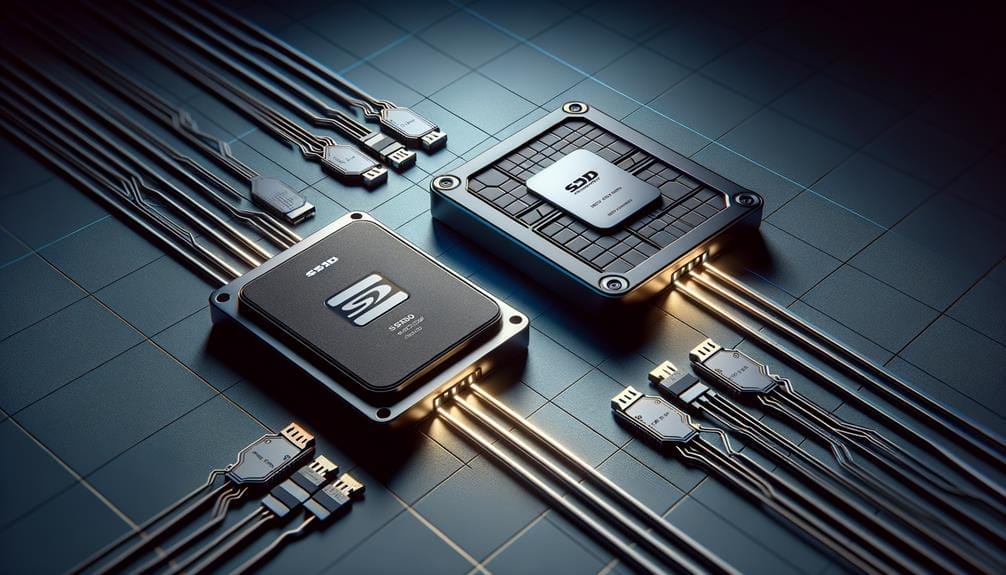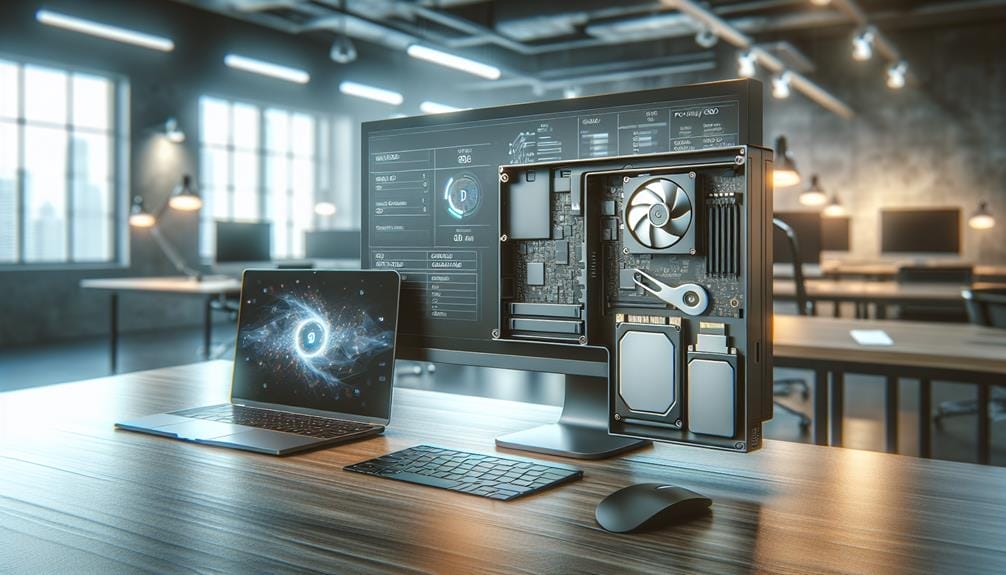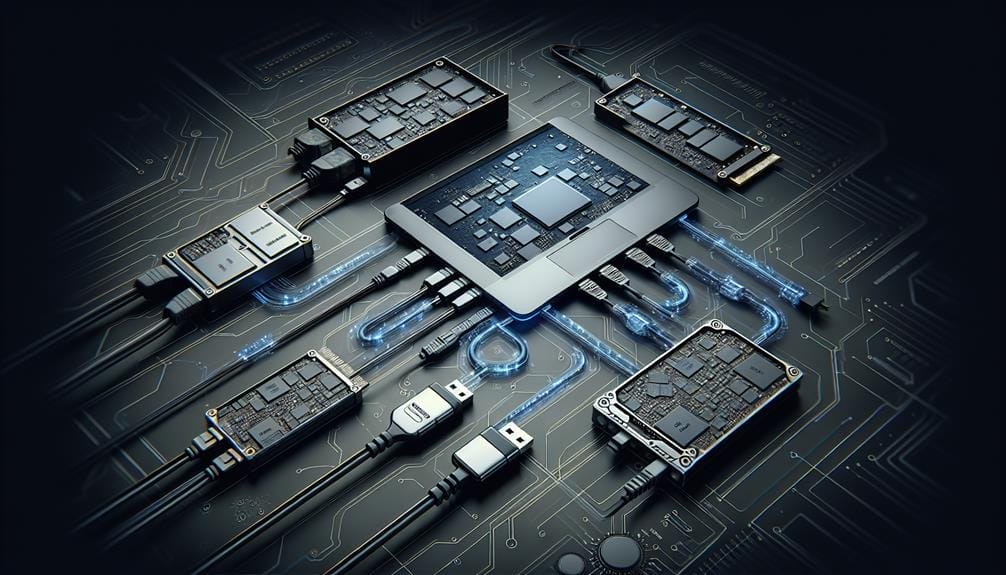Choosing Your SSD: Speed or Portability

Do you find it difficult to achieve the perfect equilibrium between superior performance and the advantages of portability when selecting the optimal SSD for your storage needs? The decision between an internal or external SSD is a common quandary for many.
Each option offers distinct advantages, but understanding the implications of your decision is essential. From interface compatibility to performance variances, there are several factors to weigh in your decision-making process.
Stay tuned to uncover the crucial insights that will help you make an informed choice that aligns with your specific storage needs.
Key Takeaways
- Internal SSDs offer faster data transfer speeds and are generally more reliable.
- External SSDs provide portability and can easily be plugged into any supporting device for use as storage.
- The choice between internal and external SSDs depends on the need for permanent storage or portability.
- Interface compatibility is crucial for optimal performance, so it is important to ensure that all interfaces are compatible.
Internal SSDs Vs. External SSDs

When choosing between internal and external SSDs, it's essential to consider factors such as performance needs, portability requirements, and device compatibility to make an informed decision.
Internal SSDs offer faster data transfer speeds, can be more reliable, and are generally less expensive. However, they require opening up the computer for installation.
On the other hand, external SSDs provide portability, easy installation, and can be easily plugged into any supporting device. They're ideal for storing data on the go but can be more expensive.
Choosing the right SSD depends on whether you prioritize permanent storage, portability, and the need for optimal speed. While internal SSDs are generally safer and less prone to accidental damage, external SSDs provide the flexibility of portability.
Ultimately, the installation process, advantages, and disadvantages of each type should be carefully weighed before making a decision.
Factors to Consider
To make an informed decision when choosing an SSD, it's crucial to carefully consider several key factors that directly impact performance and compatibility.
SSD lifespan and data security are paramount considerations. The lifespan of an SSD is influenced by the number of write cycles it can endure before performance deteriorates, so choosing an SSD with a higher endurance rating is important for longevity.
Additionally, data security features such as encryption and secure erasure capabilities are vital for protecting sensitive information.
Understanding these factors will help you select an SSD that not only meets your speed and portability requirements but also ensures reliability and data protection.
Importance of Interface Compatibility

Considering the previously discussed crucial factors for selecting an SSD, understanding the importance of interface compatibility is essential for optimizing the performance and functionality of your storage solution.
Compatibility issues can significantly impact the speed and reliability of your SSD, so it's critical to ensure that all interfaces are compatible for optimal performance. Different SSDs use various interfaces like SATA, M.2, USB, and Thunderbolt, and incompatible interfaces can result in slower speeds.
To make the most of your SSD, it's important to consider the following:
- Check device's interface support
- Ensure all interfaces are compatible
- Impact on performance
Cost Comparison
The cost comparison between internal and external SSDs reveals key differences in pricing and value for storage solutions. Internal SSDs generally offer a more cost-effective solution compared to external SSDs. When considering SSD cost analysis, it's important to factor in the additional enclosure and connectivity components that come with external SSDs, which can drive up the overall price.
On the other hand, internal SSDs, especially SATA-based ones, are often more affordable due to their straightforward installation process and lack of additional hardware. However, it's essential to weigh this against the potential need for portability and the convenience of external SSDs.
While internal SSDs may present a more budget-friendly option, the SSD price comparison should also consider the specific requirements and usage scenarios to determine the best value for your storage needs.
Speed and Performance

When evaluating the speed and performance of SSDs, it's crucial to consider the impact of the interface and the type of SSD being used. The interface compatibility greatly affects the SSD speed test results. The type of interface used, such as SATA, M.2, USB, or Thunderbolt, directly impacts the performance of the SSD. Incompatible interfaces can lead to slower speeds, so it's essential to ensure that all interfaces are compatible for optimal performance.
Interface compatibility is crucial for SSD performance. Different interfaces like SATA, M.2, USB, and Thunderbolt affect speed. Incompatible interfaces can result in slower speeds.
Understanding the impact of interface on performance is essential for making an informed decision when choosing an SSD.
Suitability for Consoles
If you're considering expanding your console's storage options, assessing the suitability of an external SSD is crucial for optimizing your gaming experience.
External SSDs can significantly improve loading times and overall performance for gaming, especially in open-world or graphically-intensive titles.
When it comes to consoles, external SSDs provide a practical solution for increasing storage capacity and enhancing gameplay. Many modern consoles support external SSDs, and some are specifically designed for gaming purposes.
The speed and reliability of an external SSD can make a noticeable difference in gaming performance, and they can also be used for video editing tasks on compatible consoles.
When choosing an external SSD for gaming or video editing, consider factors such as transfer speeds, capacity, and compatibility with your console to ensure an optimal gaming and editing experience.
Portability and Convenience

Considering the need for on-the-go storage solutions, portable external SSDs offer a convenient and efficient option for transferring and accessing data. When evaluating the portability and convenience of external SSDs, it's essential to consider the following:
- Data Transfer Limitations
Transfer speeds can be limited by the device not supporting the interface, so it's crucial to ensure compatibility for optimal performance.
- External SSD Form Factors
External SSDs come in various form factors, such as compact, rugged, and pocket-sized designs, providing flexibility for different usage scenarios.
- Interface Compatibility
The compatibility of the SSD's interface with the device is crucial for achieving the desired transfer speeds.
When choosing a portable external SSD, it's important to weigh the trade-offs between speed, portability, and compatibility with the devices you intend to use it with.
Reliability and Durability
To ensure the reliability and durability of your SSD, it's essential to consider the environmental factors that may impact its performance over time. When selecting an SSD, reliability and shock resistance are crucial for long term durability.
Internal SSDs, being directly installed within a computer, are generally more resistant to physical shocks and are less prone to accidental damage. Their stationary nature provides added protection against external forces.
On the other hand, external SSDs, though offering portability, may be more susceptible to damage due to their frequent movement. It's important to weigh the trade-offs between portability and durability based on your specific usage scenarios.
Additionally, factors such as build quality, material composition, and manufacturer reputation are significant in determining the reliability and long-term durability of an SSD.
Making the Right Choice

When making the right choice for an SSD, it's crucial to consider the pivot from the previous subtopic, which emphasized the importance of reliability and durability in relation to environmental factors impacting performance over time.
When choosing your SSD, you should carefully consider SSD form factors and capacity options.
- SSD Form Factors:
- Internal SSDs offer faster data transfer speeds and are installed directly into a computer for a more permanent solution.
- External SSDs provide portability, storage, and speed, easily plugging into a computer or any supporting device for use as storage.
Interface Compatibility is crucial for the SSD's performance, with different SSDs using various interfaces like SATA, M.2, USB, and Thunderbolt.
Conclusion
In conclusion, when choosing between speed and portability for your SSD, it's important to consider factors such as:
- Interface compatibility
- Cost
- Speed and performance
- Suitability for consoles
- Portability and convenience
- Reliability and durability
By understanding these key factors, you can make an informed decision that aligns with your specific storage needs.
Whether you prioritize blazing-fast data transfer speeds or the flexibility of a portable storage solution, taking these factors into account will help you make the best choice for your SSD.

